#Captain Bligh
Video
William Bligh's sword | National Maritime Museum | Greenwich - 29 von Paul Dykes
Über Flickr:
Sword of William Bligh, captain of the HMS Bounty, whose crew mutinied against him.
#William Bligh#sword#National Maritime Museum#Greenwich#London#HMS Bounty#Mutiny on the Bounty#Captain Bligh#anchor#flickr#age of sail#naval weapons
77 notes
·
View notes
Text
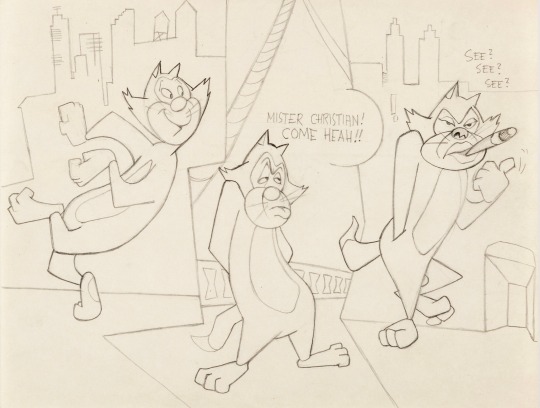
Katnip the Actor (1950s)
#50s#famous studios#harveytoons#herman and katnip#character designs#concept art#impressions#katnip#charles laughton#Captain Bligh#edward g. robinson#dave tendlar
10 notes
·
View notes
Photo


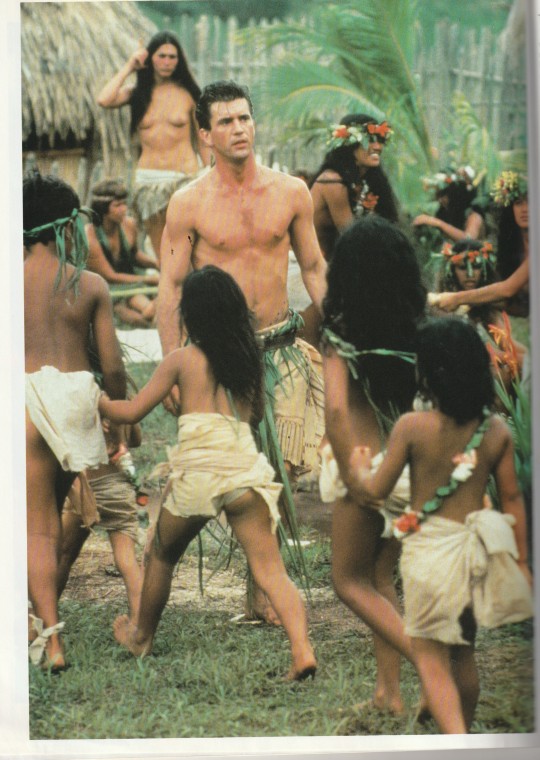



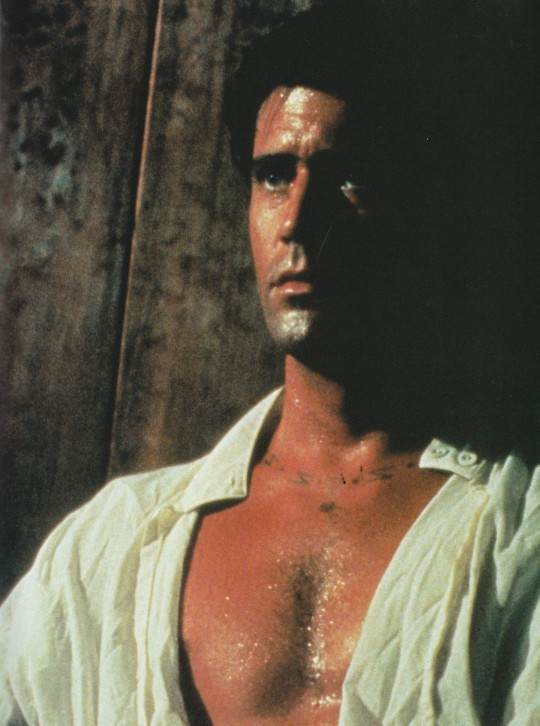

11 notes
·
View notes
Text
found out today that 'strike,' in the modern sense of a labor stoppage, comes from a group of sailors on the thames in 1768 who had various workplace grievances which they expressed before striking their ships' sails, that is, taking them down & refusing to sail
the familiar red flag comes to us from our seafaring forebears, too—mutineers used it. i love this legacy
#SO mad that i only knew about stupid captain bligh as a kid#and not the mutiny of 1797 in which more than forty thousand british sailors stopped work#and briefly established a floating republic#i am reading frykman's 'the bloody flag' about mutiny in the revolutionary atlantic rn#for too long i have been ignorant of eighteenth century maritime labor!!!#it's on li/bg/en if you're curious#my grandfather wrote about british conscription but not in this period. still. a nice quiet resonance
18 notes
·
View notes
Text
The [...] British quest for Tahitian breadfruit and the subsequent mutiny on the Bounty have produced a remarkable narrative legacy [...]. William Bligh’s first attempt to transport the Tahitian breadfruit [from the South Pacific] to the Caribbean slave colonies in 1789 resulted in a well-known mutiny orchestrated by his first mate [...]. [T]he British government [...] successfully transplanted the tree to their slave colonies four years later. [...] [There was a] colonial mania for [...] the breadfruit, [...] [marked by] the British determination to transplant over three thousand of these Tahitian food trees to the Caribbean plantations to "feed the slaves." [...]
Tracing the routes of the breadfruit from the Pacific to the Caribbean, [...] [shows] an effort initiated, coordinated, and financially compensated by Caribbean slave owners [...]. [During] decades worth of lobbying from the West Indian planters for this specific starchy fruit [...] planters [wanted] to avert a growing critique of slavery through a "benevolent" and "humanitarian" use of colonial science [...]. The era of the breadfruit’s transplantation was marked by a number of revolutions in agriculture (the sugar revolution), ideology (the humanitarian revolution), and anticolonialism (the [...] Haitian revolutions) [as well as the American and French revolutions]. [...] By the end of Joseph Banks’ tenure [as a botanist and de facto leader] at the Kew Botanical Gardens [royal gardens in London] (1821), he had personally supervised the introduction of over 7,000 new food and economic plants. [...] Banks produced an idyllic image of the breadfruit [...] [when he had personally visited Tahiti while part of Captain Cook's earlier voyage] in 1769 [...].
---
[I]n the wake of multiple revolutions [...], [breadfruit] was also seen as a panacea for a Caribbean plantation context in which slave, maroon, and indigenous insurrections and revolts in St Vincent and Jamaica were creating considerable anxiety for British planters. [...]
Interestingly, the two islands that were characterized by ongoing revolt were repeatedly solicited as the primary sites of the royal botanical gardens [...]. In 1772, when St Vincentian planters first started lobbying Joseph Banks for the breadfruit, the British militia was engaged in lengthy battle with the island’s Caribs. [...] By 1776, months after one of the largest slave revolts recorded in Jamaica, the Royal Society [administered by Joseph Banks, its president] offered a bounty of 50 pounds sterling to anyone who would transfer the breadfruit to the West Indies. [...] [A]nd planters wrote fearfully that if they were not able to supply food, the slaves would “cut their throats.” It’s widely documented that of all the plantation Americas, Jamaica experienced the most extensive slave revolts [...]. An extensive militia had to be imported and the ports were closed. [...]
By seeking to maintain the plantation hierarchy by importing one tree for the diet of slaves, Caribbean planters sought to delay the swelling tide of revolution that would transform Saint Domingue [Haiti] in the next few years. Like the Royal Society of Science and Arts of Cap François on the eve the Haitian revolution, colonists mistakenly felt they could solve the “political equation of the revolution […] with rational, scientific inquiry.” [...]
---
When the trees arrived in Jamaica in 1793, the local paper reported almost gleefully that “in less than 20 years, the chief article of sustenance for our negroes will be entirely changed.” […] One the one hand, the transplantation of breadfruit represented the planters’ attempt to adopt a “humanitarian” defense against the growing tide of abolitionist and slave revolt. In an age of revolution, [they wanted to appear] to provide bread (and “bread kind”) [...]. This was a point not to be missed by the coordinator of the transplantation, Sir Joseph Banks. In a letter written while the Bounty was being fitted for its initial journey, he summarized how the empire would benefit from new circuits of botanical exchange:
Ceres was deified for introducing wheat among a barbarous people. Surely, then, the natives of the two Great Continents, who, in the prosecution of this excellent work, will mutually receive from each other numerous products of the earth as valuable as wheat, will look up with veneration the monarch […] & the minister who carried into execution, a plan [of such] benefits.
Like giving bread to the poor, Banks articulated this intertropical trade in terms of “exalted benevolence,” an opportunity to facilitate exchange between the peoples of the global south that placed them in subservience to a deified colonial center of global power. […]
---
Bligh had no direct participation in the [slave] trade, but his uncle, Duncan Campbell (who helped commission the breadfruit journey), was a Jamaican plantation owner and had employed Bligh on multiple merchant ships in the Caribbean. Campbell was also deeply involved, with Joseph Banks, in transporting British convicts to the colonies of Australia. In fact Banks’ original plan for the breadfruit voyage was to drop off convicts in (the significantly named) Botany Bay, and then proceed to Tahiti for the breadfruit. Campbell owned a series of politically untenable prison hulks on the Thames which he emptied by shipping his human chattel to the Pacific. Banks helped coordinate these early settlements [...] to encourage white Australian domesticization.
The commodification and rationalist dispersal of plants and human
convicts, slaves, the impoverished, women, and other unwilling participants in global transplantation is a rarely told narrative root of colonial “Bounty.”
---
All text above: Elizabeth DeLoughrey. “Globalizing the Routes of Breadfruit and Other Bounties”. Journal of Colonialism and Colonial History Volume 8, Number 3, Winter 2007. [Bold emphasis and some paragraph breaks/contractions added by me. Presented here for commentary, teaching, criticism purposes.]
#abolition#incredible story of ecology violence hubris landscape cruelty interconnectivity and rebellion
22 notes
·
View notes
Text












Closure - Appendage // Live at The Astoria // Nine Inch Nails - Piggy // Live at De Doelen // Interview with Legends & Masters Show // Lipps Service Podcast // Filter - Captain Bligh // Rock & Roll Hall of Fame Q&A // Filter - Jurassitol // Richard Patrick’s Instagram // Filter - No Love
119 notes
·
View notes
Text
#OnThisDay in 1789 – the mutiny on the Bounty happened.
The HMS Bounty was taken over in a mutiny led by first mate Fletcher Christian. Captain William Bligh and 18 of his loyal supporters were set adrift.

15 notes
·
View notes
Text
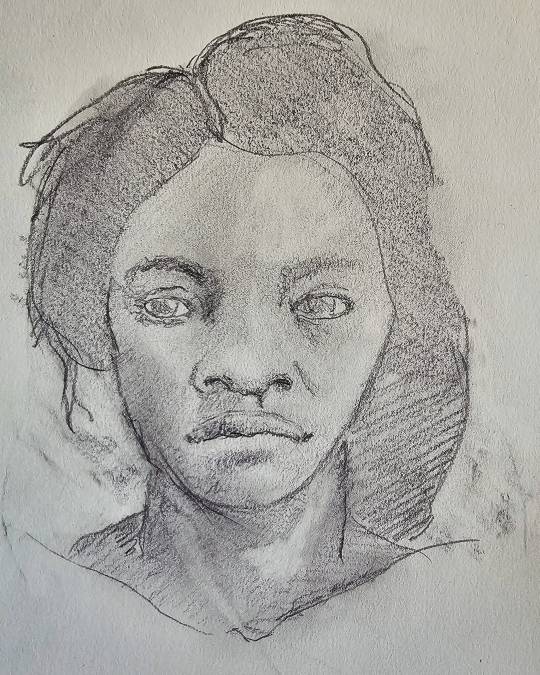
Pencil drawing on paper
Calbayog City 2024
I think a lot about those guys on the HMS Bounty. They had been ashore on Tahiti living in paradise with the native Tahitians for several months and then suddenly Captain Bligh tells them it's time to go back to stinky old England.
I would have mutinied too. Damn right!!
I did this drawing this morning. Above is the original sketch and below is the final after I cleaned it up. I like both but the initial drawing had more energy. So it goes.

3 notes
·
View notes
Text
I want to make a longer post about OFMD Blackbeard and Captain Bligh at some point but that might require re-reading Mutiny on the Bounty (something I am frankly not going to do) so here is the short version.
Captains in the age of sail walked a fine line. They couldn't be too familiar with the crew but they couldn't be too distant and high handed. They couldn't let rule violations slide for risk of losing control but they also couldn't be too strict. They had to be willing to punish bad behavior but they couldn't be brutal. They (ideally) had to inspire the crew to endure the difficult conditions at sea and the horror of naval battles but they also couldn't be friends with the crew. Basically, a good captain was always on and always thinking. It was not easy.
I'm not saying this hierarchical structure was good. But it's definitely interesting and creates wonderful dynamics for fiction.
Captain Bligh isn't fictional. He was a British captain (and fuckhead colonizer who sailed with James Cook) whose crew mutinied and set him and the crew members loyal to him adrift in a dinghie with some food, fresh water, and a compass. He wrote a memoir about it where he tried to make himself sound reasonable and smart but probably protested too much.
Basically, Bligh lost control. His punishments were considered unfair and he made some decisions that the crew disagreed with strongly. Oops. Rowboat for you! Union strong and all that. I'm generally a fan of mutinies, myself. Anyway.
Blackbeard never loses control. His return during the mutiny against Izzy quells the rebellion immediately. Both his crew and Stede's respect him and I'd argue it's because he walks the captain line extremely well.
But, of course, that's terribly lonely, isn't it? Sometimes captains would invite a companion to sail with them so they'd have someone to talk to over dinner. This was a class thing (yuck), but it was also a function of not having anyone on board who they didn't command.* Ed has Izzy (who he does command). Which. Well.... And for a while he had Stede as a co-captain.
TLDR; Ed is extremely competent and Captain Blackbeard is very carefully maintained. But it's fucking wearing.
"You wanted to be Blackbeard. This is what it's like."
*Charles Darwin was just such a voyage companion for a captain named FitzRoy. It's part of how Darwin developed his ideas for Origin of the Species.
63 notes
·
View notes
Text
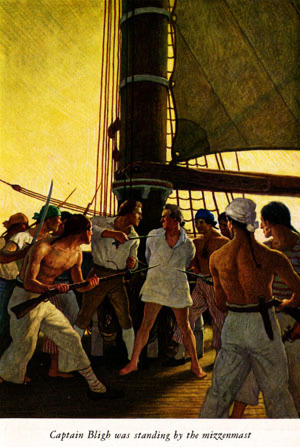
N. C. Wyeth
Captain Bligh was standing by in the mizzenmast
Illustration from The Bounty Trilogy
ca. 1940
#n.c. wyeth#book illustration#illustrator#american artist#american painter#mutiny on the bounty#mutiny#modern art#art history#american art#aesthetictumblr#tumblraesthetic#tumblrpic#tumblrpictures#tumblr art#tumblrstyle#artists on tumblr#aesthetic#tumblrposts
5 notes
·
View notes
Note
How accurate is the 1962 movie Mutiny on the Bounty, in terms of sailing? Also, what are you thoughts on Captain Bligh?
Hi,
I can tell you when I've seen the film. But about Captain Bligh - do you mean the historical one or the one in the film? Have a nice day
9 notes
·
View notes
Text
look i try to be a good person but actually on every level except physical i am charles laughton as captain bligh yelling “KEELHAUL THIS MAN”
19 notes
·
View notes
Text
The R - Part 1:
What is the connection between Mr Remora and Duchess R [of Winnipeg]?
One of the many mysteries that Lemony Snicket has left behind for readers (and viewers, to a certain extent) is 'What does the R stand for, in "Duchess R" ?' I am going to attempt to answer this question using any resources available, under the title 'The R'. This will be over a series of unfortunate posts, in this format.
Firstly, we must look for any and all clues that can give us even the slightest hint as to what R might stand for.
For this, I have gone through every character in ASOUE and this is produced: (after the cut, but feel free to skip ahead)
Lemony Snicket
Violet Baudelaire
Klaus Baudelaire
Sunny Baudelaire
Count Olaf
Bald Man with the Long Nose
Mrs. Bass
Beatrice Baudelaire
Beatrice Baudelaire II
Bertrand Baudelaire
Bruce
Colette
Fernald
Hal
Henchperson of Indeterminate Gender
Hugo
Incredibly Deadly Viper
Geraldine Julienne
Kevin
Kind Editor
Man with a Beard but No Hair
Vice Principal Nero
Phil
Arthur Poe
Duncan Quagmire
Isadora Quagmire
Quigley Quagmire
Mr. Remora
Carmelita Spats
Kit Snicket
Esmé Squalor
Jerome Squalor
Justice Strauss
White-Faced Women
Woman with Hair but No Beard
Albert Poe
Edgar Poe
Polly Poe
Wart-Faced Man
Alaskan Cow Lizard
Androgynous Cobra
Madame diLustro
Dissonant Toad
Green Gimlet Toad
Inky Newt
Irascible Python
O. Lucafont
Mamba du Mal
Monty Montgomery
Monty Montgomery's Sister
Gustav Sebald
Stephano
Virginian Wolfsnake
Ike Anwhistle
Josephine Anwhistle
Bertrand Baudelaire's Cousin
Gina-Sue
Larry Your-Waiter
Captain Sham
Charles
Foreman Firstein
Flacutono
Georgina Orwell
Shirley
Sir
Elwyn
Coach Genghis
Ms. Tench
Ben
Gunther
Chief of Police
Council of Elders
Detective Dupin
Hector
Mr. Lesko
Officer Luciana
Mrs. Morrow
Verhoogen Family
V.F.D. Crows
Babs
Bearded Man
Laura V. Bleediotie
Lou
Mattathias
Milt
Mr. Sirin
Volunteers Fighting Disease
Beverly and Elliot
Olivia Caliban
Chabo the Wolf Baby
Man With Pimples On His Chin
Ringmaster
Volunteer Feline Detectives
Infant Servant
C.M. Kornbluth
Snow Gnats
Snow Scouts
V.F.D. Eagles
White-Faced Women's Sibling
Winnipeg Scout
Gregor Anwhistle
Fiona
The Great Unknown
Captain Widdershins
Mrs. Widdershins
Count Olaf's father
Count Olaf's mother
Dewey Denouement
Ernest Denouement
Frank Denouement
Alonso
Ariel
Jonah Bellamy
Sadie Bellamy
Rabbi Bligh
Brewster
Byam
Friday Caliban
Miranda Caliban
Calypso
Erewhon
Ferdinand
Finn
Professor Fletcher
Gonzalo
Ishmael
Dr. Kurtz
Larsen
Ms. Marlow
Monday
Madame Nordoff
Omeros
Mr. Pitcairn
Robinson
Sherman
Thursday
Weyden
Willa
Beekeeper
Building Committee
Emily Dickinson
Dolores
Esmé Squalor Fan Club
Gerta
Daniel Handler
Haruki
Ivan Lachrymose
Eleanora Poe
Lena Pukalie
Duchess R
R's Mother
R's Father
Young Rölf
Sally Sebald
Shoemaker
A. Snicket
B. Snicket
Chas. Snicket
D. Snicket
E. Snicket
F. Snicket
G
H
I
Jacob Snicket
M
N
O
Mr. Spats
Mrs. Spats
Town Fathers
Valorous Farms Dairy
Baron van de Wetering
Yeah. Every single one.
Now, let's rule out everyone who does not have a name beginning with R, or is unclear: (again, feel free to skip ahead)
Bald Man with the Long Nose
Mrs. Bass
Henchperson of Indeterminate Gender
Incredibly Deadly Viper
Kind Editor
Man with a Beard but No Hair
Mr. Remora
White-Faced Women
Woman with Hair but No Beard
Wart-Faced Man
Madame diLustro
Monty Montgomery's Sister
Bertrand Baudelaire's Cousin
Foreman Firstein
Coach Genghis
Ms. Tench
Verhoogen Family
Mr. Sirin
Man With Pimples On His Chin
Infant Servant
White-Faced Women's Sibling
Winnipeg Scout
The Great Unknown
Captain Widdershins
Mrs. Widdershins
Count Olaf's father
Count Olaf's mother
Rabbi Bligh
Dr. Kurtz
Ms. Marlow
Madame Nordoff
Mr. Pitcairn
Robinson
Beekeeper
Duchess R
R's Mother
R's Father
Young Rölf
Mr. Spats
Mrs. Spats
Town Fathers
As the title states, we'll keep some focus on Remora, but we'll eliminate all other minor characters:
Bald Man with the Long Nose
Henchperson of Indeterminate Gender
Incredibly Deadly Viper
Kind Editor
Man with a Beard but No Hair
Mr. Remora
White-Faced Women
Woman with Hair but No Beard
Wart-Faced Man
Madame diLustro
Monty Montgomery's Sister
Bertrand Baudelaire's Cousin
Robinson
Duchess R
R's Mother
R's Father
Young Rölf
According to Various Fan Deductions:
TMWABBNH & TWWHBNB are Gifford & Ghede
The White-Faced Women are Zada and Zora
Lemony's Kind Editor is Moxie Mallahan
Madame diLustro is Sunny Baudelaire
This rules out the 4 of them.
Bald Man with the Long Nose
Henchperson of Indeterminate Gender
Incredibly Deadly Viper
Mr. Remora
Wart-Faced Man
Monty Montgomery's Sister
Bertrand Baudelaire's Cousin
Robinson
Duchess R
R's Mother
R's Father
Young Rölf
Logically speaking, why would there be a connection between Ink and Duchess R? Let's eliminate unlikely possibilities:
Mr. Remora
Monty Montgomery's Sister
Bertrand Baudelaire's Cousin
Robinson
Duchess R
R's Mother
R's Father
Young Rölf
Monty Montgomery's sister would be (_insert name here_) Montgomery. This, to me, rules her out too... and the same logic applies to Bertrand's cousin.
Mr. Remora
Robinson
(Duchess R)
(R's Mother)
(R's Father)
Young Rölf
Obviously her family are related:
Mr. Remora
Robinson - Islander
Young Rölf
So, the above names are generated. I will, henceforth, analyse a link between each character and R, starting with Remora.
POINTS:
a. It's known that a few characters in the Snicket-verse have alliterating names, such as Quigley Quagmire, Beatrice Baudelaire.
b. It's also known that some characters have WEIRD connections to others, such as Quigley's 'relation' to Mr Poe.
THEORY: Given a. and b. to be true, Mr R _______ Remora, has some abstract connection to the Duchess.
This connection can only really be established if one goes by Netflix canon and assumes Nero's surname to be Feint, and combines this with ATWQ:
Duchess R is Remora's boss' ancestor's murderer's friend.
R's friend is Lemony, who murdered Hangfire, who is the ancestor of Nero, Remora's boss.
Part 2 Still to Come...
¬ Th3r3534rch1ngr4ph, Unfortunate Theorist/Snicketologist
#asoue#vfd#lemony snicket#a series of unfortunate events#snicketverse#asoue netflix#theory#duchess of winnipeg#duchess r#hangfire#vice principal nero#nero feint#mr remora#part 1
5 notes
·
View notes
Photo


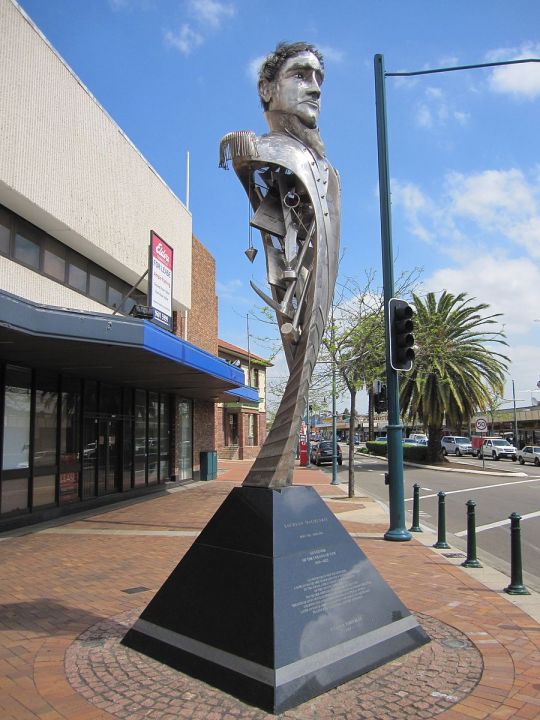
On January 31st 1761 Lachlan MacQuarie, was born on Ulva, a small isle off the island of Mull.
Lachlan joined the Army in 1776 (aged 14) and served in Nova Scotia as well as New York and Jamaica. As a lieutenant he served in India from 1787 to 1801 and later in Egypt where he was involved in defeating the army of Napoleon.
In 1810 Macquarie became Governor of New South Wales at a time when it was still being used as a penal colony. The previous Governor had been Captain Bligh of the “Bounty”.
Macquarie followed a policy of encouraging the former convicts to settle in Australia - despite opposition from the “free settlers” who wanted to retain privileges only for themselves. Australia would be a different place if he had not succeeded. He transformed Australia into a thriving country and Sydney from a shanty town to a Georgian city and is regarded as the “Father of Australia”.
His policy concerning the Aboriginals was an expression of the same humanitarian conscience. He organized the Native Institution (a school for Aboriginal children), a village at Elizabeth Bay for the Sydney tribe, an Aboriginal farm at George’s Head. Orders of merit and even an old general’s uniform were bestowed on deserving chiefs.
It must be noted also that he ordered The Appin Massacre, to round up all Aboriginal people in the area after some unrest. Those who resisted were to be shot. On 16 April 1816, at least 14 were killed by shooting; others were driven to jump to their deaths into a rocky gorge, near Broughton Pass.
So he wasn’t perfect, but who is, a bit of a rogue as well by all accounts, was adverse a wee bit of embezzlement, but managed to wriggle out of it, “laws” he laid down were of the strict Presbyterian upbringing on the Islands on the Inner Hebrides, nude sunbathing was banned as was “shooting a neighbour’s dog on a Sunday”
As a Scot his ability to have a good drink were evident, of his army life in India he “took to the field” with “eight dozen bottles of brandy and Madeira” and “a quantity of gin”. One of his diary entries, penned after a big night out, shakily read, “No beer for three months’!
For the Australians reading this Lachlan also set aside land in Sydney for "recreation and amusement of the inhabitants of the town” He named it Hyde Park, it was here Australia’s first sanctioned horse racing took place. At one of the fairs at the park he organised, “ladies raced in sacks for a cheese” where men would bet on the results and have a laugh! At another two men competed in a mile foot race before slugging it out for 56 rounds in Australia’s first bare knuckle prize fight. Now the remark about the sack race might make you think he was a misogynist, maybe he was, but he was ahead of his time and a revolutionary for the fairer sex, giving plum jobs to women, with reformed banknote thief Elizabeth Killett appointed to run the Sydney Market.
But his liberal attitude to the convicts finally was his downfall, Macquarie’s critics sparked a British government inquiry into his rule and the governor resigned, setting sail for Britain in 1822 with a shipload of kangaroos for his friends and patrons it was said that…
“as a Scotsman he was drawn to an animal with an inbuilt sporran”.
Other men may lay claim to be “The Father of Australia” but are any as colourful as oor Lachlan?
Macquarie died in London in 1824 while fighting charges made against him as Governor. He was buried in a Mausoleum on the Isle of Mul in a mausoleum near Salen with his wife, daughter and later son. The grave is maintained by the National Trust of Australia and is inscribed “The Father of Australia”.
As I stated earlier, and with a lot of these anniversaries about people born during the days of the British Empire, Macquarie was heavily involved in atrocities. I will point to one quote attributed to him....... in 1816 around the time of the Appin massacre, that all Indigenous people “from Sydney onwards are to be made prisoners of war, and if they resist they are to be shot and their bodies hung from trees in the most conspicuous places near where they fall, so as to strike terror into the hearts of the surviving natives”
You can find out loads about him online one of the sources can be found at the link at the bottom. The BBC made a drama-documentary in 2011 called The Father of Australia, https://nativistherald.com.au/2018/04/20/australias-founding-fathers-lachlan-macquarie/
13 notes
·
View notes
Text
109. Mutiny on the Bounty, by Peter Fitzsimons

Owned: No, library
Page count: 562
My summary: An account of the famous Mutiny on the Bounty, where a crew of Naval sailors mutinied against their tyrannical captain - but unfortunately, the captain made it back to England, and the mutineers found themselves in hotter waters.
My rating: 4/5
My commentary:
If you've been following this blog for any amount of time, you'll know that I love Boat Media. If it's set more than one hundred years ago on some sort of ship, I'm into it, especially if it's in any way based on or about real incidents. With this in mind, it's weird that I didn't know much about the mutiny on the Bounty before reading this book. It's only one of the most famous naval mutinies in English history, after all - a complex tale of a captain driven to the edge, and a crew forced to live with a tyrant. Adding to that are racial and sexual politics, as well as the imperialist nature of the white crew versus the native people. It's an absolutely fascinating piece of history, and this book represents it well! It's told in almost a prose style, though the author takes pains to point out that all dialogue is either taken from a primary source or is assumed based on other evidence. The book has an extensive bibliography, and the citations in the text are plenty. I did find that this framing was a little sensationalised at times - the focus by the author on the attractive Tahitian women trended towards the misogynistic, as well as being exoticising and fetishising. But overall, this is both a comprehensive and an entertaining account of the mutiny on the Bounty.
This is really a story about class, rank, and power. The captain, Bligh, was a tyrant and a monster, ready to punish and even execute his crew for the smallest perceived slight. The crewmen rightfully mutinied against him, risking their lives in the doing, but began to fall apart themselves once they returned to Tahiti. See, many of the men had taken Tahitian women either as wives or concubines, and insisted on taking them to Pitcairn Island, where they eventually hid out. Along with them were a few Tahitian men. Now, you might think that the mostly-white English crewmen, remembering how poorly they were treated by Bligh, might have considered the Tahitians their equals and not essentially enslaved them and given them far fewer rights and belongings on the island. But the mutineers were just as racist as their fellow white men! Which led to a lot of them being killed by the Tahitians when they were pushed too far, and the Tahitian men were killed in turn. Also, the English men treated the Tahitians like they were idiots even before this incident. They were patronising and assumed ignorance and mocked the Tahitians' culture, despite theirs not exactly being the best either.
Meanwhile, back in England, many of the crew who were loyal to the Captain but wound up still on the Bounty with the mutineers were accused of being mutineers themselves. One, a midshipman, managed to escape the death penalty by leveraging his family's money and connections. Another also was pardoned. Three, including a teenager, were not so lucky, and were hanged for mutiny against their tyrannical Captain after being imprisoned in awful conditions. After Bligh returned to England, he was treated as a hero, but by the time the midshipman and others were returned, people were beginning to realise what a bastard this man was. And yet, he continued to be a Captain. Because damn it, he was a Navy man, and as the Captain of the ship was not in line to be summarily executed for treating his crew like dogs. Whereas mutiny? That was a hanging offence, and one laid on the heads of the mutineers. Mutineers must only have mutinied because they were evil, you see. Never mind that their Captain was abusing them, punishing them for next to nothing, and was so awful that this wasn't even the last time he would be mutinied against. Class in 19th century society sure was something.
Next up, we're back to CHERUB, as James goes on his first full mission.
3 notes
·
View notes
